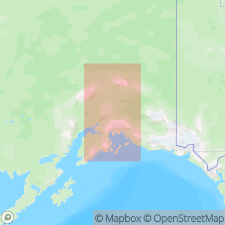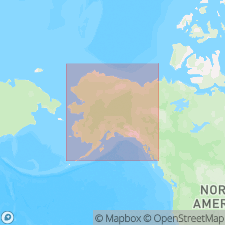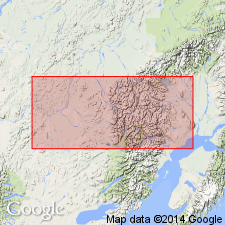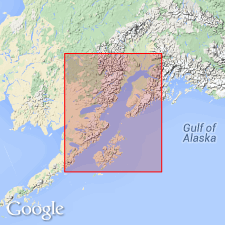
- Usage in publication:
-
- Matanuska series*
- Modifications:
-
- Named
- Biostratigraphic dating
- Dominant lithology:
-
- Shale
- Conglomerate
- Limestone
- AAPG geologic province:
-
- Alaska Southern region
Summary:
Exposed in Matanuska Valley; Matanuska River flows nearly along strike of series. Consists chiefly of shales (red, green, and buff), many coarser beds including heavy bed of conglomerate not less than 1000 ft thick at base of Castle Mountain. Limestone bed, 300 ft thick, is exposed near Limestone Gap and along upper course of Bubb Creek. Tentatively assigned Early Cretaceous age on basis of few fossils collected at head of Bubb Creek.
Source: GNU records (USGS DDS-6; Menlo GNULEX).

- Usage in publication:
-
- Matanuska formation*
- Modifications:
-
- Revised
- Biostratigraphic dating
- Dominant lithology:
-
- Shale
- Sandstone
- AAPG geologic province:
-
- Alaska Southern region
Martin, G.C., 1926, Mesozoic stratigraphy of Alaska: U.S. Geological Survey Bulletin, 776, 493 p.
Summary:
Included in Matanuska series of Mendenhall (1900) which ranged in age from Early Jurassic to late Tertiary. Upper Cretaceous rocks of Matanuska Valley are designated Matanuska formation. Most complete measured section is on Granite Creek beginning at lower end of canyon, 1.75 mi from mouth of creek. Other good sections exposed on Kings River and in cliffs of Matanuska River. Consists of shale and sandstone with some conglomerate. Is 4000 ft thick at Granite Creek. Probably rests unconformably on rocks of Early Jurassic to Early Cretaceous age. Unconformably underlies Tertiary arkose and conglomerate. Age is Late Cretaceous based on marine mollusks identified by T.W. Stanton.
Source: GNU records (USGS DDS-6; Menlo GNULEX).

- Usage in publication:
-
- Matanuska Formation*
- Modifications:
-
- Age modified
- Biostratigraphic dating
- Overview
- AAPG geologic province:
-
- Alaska Southern region
Summary:
Type area is in Matanuska Valley; more completely exposed sections are in Nelchina area. Age ranges from Albian to Maestrichtian based on fossil collections identified by D.L. Jones (list and localities included). Historical overview of work of previous authors, geologic sketch map, correlation chart, measured sections also included in report.
Source: GNU records (USGS DDS-6; Menlo GNULEX).

- Usage in publication:
-
- Matanuska Formation*
- Modifications:
-
- Areal extent
- AAPG geologic province:
-
- Alaska Southern region
Summary:
Arbitrary geographic boundary between Matanuska Formation on north and Kaguyak Formation on south set at about 60 deg 30'N, latitude of Kalgin Island. In Matanuska Valley at least 1250 m (4100 ft) of Campanian and Maestrichtian rocks of Matanuska Formation are exposed (Grantz, 1964).
Source: GNU records (USGS DDS-6; Menlo GNULEX).
For more information, please contact Nancy Stamm, Geologic Names Committee Secretary.
Asterisk (*) indicates published by U.S. Geological Survey authors.
"No current usage" (†) implies that a name has been abandoned or has fallen into disuse. Former usage and, if known, replacement name given in parentheses ( ).
Slash (/) indicates name conflicts with nomenclatural guidelines (CSN, 1933; ACSN, 1961, 1970; NACSN, 1983, 2005, 2021). May be explained within brackets ([ ]).

